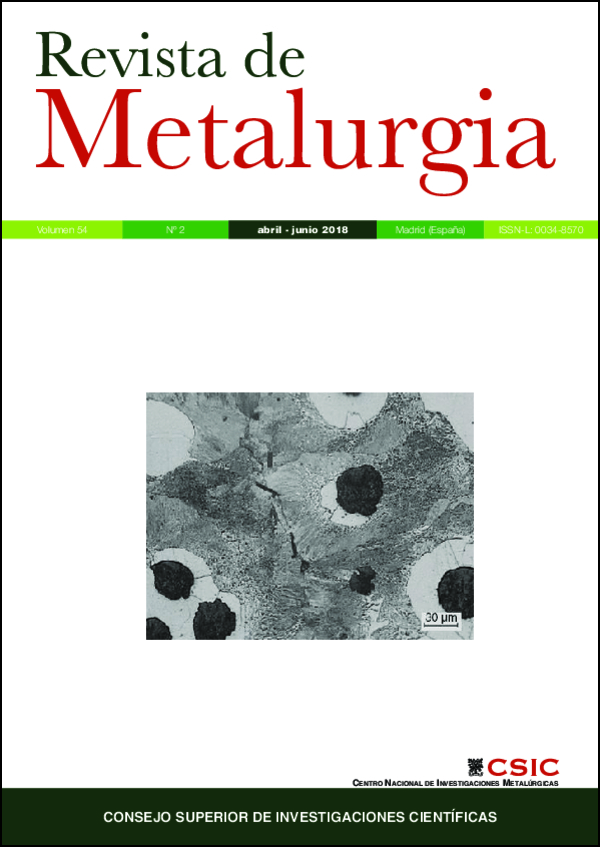The mechanical and tribological characteristic of Aluminium-Titanium dioxide composites
DOI:
https://doi.org/10.3989/revmetalm.119Keywords:
Aluminium, TiO2, Induction sintering, Powder metallurgyAbstract
The purpose of this work was to investigate the mechanical and tribological effects of Titanium dioxide (TiO2) reinforcement in Aluminium (Al). Aluminium composites consist of 99.8% pure aluminium reinforced with five different partions of TiO2. Aluminium powders were mixed with TiO2 by ball milling for 30 minutes in a planetary mixer. The powder mixture was compacted by the cold pressing technique at 250 MPa. Two different methods used for sintering. The green compact was sintered at 600 °C for 300 seconds in open atmosphere with an Ulta-High Frequency Induction System (UHFIS) and with furnace at 600 °C for 1800 seconds. The mechanical and microstructural properties of examples were compared for different amount of reinforcement. We have observed a maximum hardness for 5 wt.% TiO2 reinforced composites.
Downloads
References
Aniolek, K., Kupka, M., Barylski, A. (2016). Sliding wear resistance of oxide layers formed on a titanium surface during thermal oxidation. Wear 356–357, 23–29. https://doi.org/10.1016/j.wear.2016.03.007
Chen, G.X., Zhau, Z.R. (2003). Correlation of a negative friction-velocity slope with sequal generation under reciprocating conditions. Wear 255, 376–384. https://doi.org/10.1016/S0043-1648(03)00052-8
Chuang, L.-C., Luo, C.-H., Yang, S.-H. (2011). The structure and mechanical properties of thick rutile-TiO2 films using different coating treatments. Appl. Surf. Sci. 258 (1), 297–303. https://doi.org/10.1016/j.apsusc.2011.08.055
Çavdar, U., Gül?ahin, ?. (2014). Ultra high frequency induction welding of powder metal compact. Rev. Metal. 50 (2), e016. https://doi.org/10.3989/revmetalm.016
Çavdar, P.S., Çavdar, U. (2015). The evaluation of different environments in ultra-high frequency induction sintered powder metal compacts. Rev. Metal. 51 (1), e036. https://doi.org/10.3989/revmetalm.036
Gökçe, A., Fındık, F. (2008). Mechanical and physical properties of sintered aluminum powders. J. Achiev. Mater. Manuf. Eng. (JAMME) 30 (2), 157–164. https://citeseerx.ist.psu.edu/viewdoc/download?doi=10.1.1.563.1942&rep=rep1&type=pdf.
Hassani, A., Bagherpour, E., Qods, F. (2014). Influence of pores on workability of porous Al/SiC composities fabricated through powder metallurgy mechanical alloying. J. Alloy. Compd. 591, 132–142. https://doi.org/10.1016/j.jallcom.2013.12.205
Khodabakhshi, F., Simchi, A., Kokabi, A.K., Gerlich, A.P., Nosko, M. (2014). Effects of post-annealing on the microstructure and mechanical properties of friction stir processed Al-Mg-TiO2 nanocomposites. Mater. Design 63, 30–41. https://doi.org/10.1016/j.matdes.2014.05.065
Leng, Y.X., Chen, J.Y., Yang, P., Sun, H., Huang, N. (2007). The microstructure and properties of titanium dioxide films synthesized by unbalanced magnetron sputtering. Nucl. Instrum. Meth. B 257 (1–2), 451–454. https://doi.org/10.1016/j.nimb.2007.01.096
Li, D., Chen, S., Wang, D., Li, Y., Shao, W., Long, Y., Liu, Z., Ringer, S.P. (2010). Thermo-analysis of nanocrystalline TiO2 ceramics during the whole sintering process using differential scanning calorimetry. Ceram. Int. 36 (2), 827–829. https://doi.org/10.1016/j.ceramint.2009.10.004
Lin, D.C., Wang, G.X., Srivatsan, T.S., Al-Hajri, M., Petraroli, M. (2003). Influence of titanium dioxide nanopowder addition on microstructural development and hardness of tin-lead solder. Mater. Lett. 57 (21), 3193–3198. https://doi.org/10.1016/S0167-577X(03)00023-5
Lumley, R. (2011). Fundamentals of Aluminium Metallurgy: Production, Processing and applications. 1st Edition, Woodhead Publishing Limited, p. 678. https://doi.org/10.1533/9780857090256
Mazaheri, M., Zahedi, A.M., Haghighatzadeh, M., Sadrnezhaad, S.K. (2009). Sintering of titania nanoceramic: Densification and grain growth. Ceram. Int. 35 (2), 685–691. https://doi.org/10.1016/j.ceramint.2008.02.005
Pinto, D., Bernardo, L., Amaro, A., Lopes, S. (2015). Mechanical properties of epoxy nanocomposities using titanium dioxide as reinforcement – A review. Constr. Build. Mater. 95, 506–524. https://doi.org/10.1016/j.conbuildmat.2015.07.124
Piwo?ski, I. (2007). Preparation method and some tribological properties of porous titanium dioxide layers. Thin Solid Films 515 (7–8), 3499–3506. https://doi.org/10.1016/j.tsf.2006.10.115
Pydi, H.P.R., Adhithan, B., Bakrudeen, A.S.B. (2013). Microstructure Exploration of the Aluminum-Tungsten Carbide Composite with different Manufacturing circumstances. IJSCE 2 (6), 257–261.
Raut, A., Choudhary, D. (2015). Nano enabled coatings makes aircraft invisible. Int. J. Pure Appl. Res. Eng. Techn. (IJPRET) 3 (9), 134–146. http://www.ijpret.com/publishedarticle/ 2015/4/IJPRET%20-%20MECH%20127.pdf.
Shin, J.H., Choi, H.J., Bae, D.H. (2013). Evolution of the interfacial layer and its effect on mechanical properties in TiO2 nanoparticle reinforced aluminium matrix composites. Mat. Sci. Eng. A-Struct. 578, 80–89. https://doi.org/10.1016/j.msea.2013.04.069
Singh, M., Goyal, K., Goyal, D.K. (2015). Fabrication performance of aluminium based metal matrix composites with SiO2 and TiO2 as reinforced particles. Universal J. Mech. Eng. 3 (4), 142–146. https://doi.org/10.13189/ujme.2015.030404
Sorkhe, Y.A., Aghajani, H., Tabrizi, A.T. (2014). Mechanical alloying and sintering of nanostructured TiO2 reinforced copper composite and its characterization. Mater. Design 58, 168–174. https://doi.org/10.1016/j.matdes.2014.01.040
Tubio, C.R., Guitián, F., Salguerio, J.R., Gil, A. (2015). Anatase and rutile TiO2 monodisperse microspheres by rapid thermal annealing: A method to avoid sintering at high temperaturas. Mater. Lett. 141, 203–206. https://doi.org/10.1016/j.matlet.2014.11.063
Xiang, N., Song, R., Zhao, J., Li, H., Wang, C., Wang, Z. (2015). Microstructure and mechanical properties of ceramic coatings formed on 6063 aluminium alloy by micro-arc oxidation. T. Nonferr. Metal. Soc. 25 (10), 3323–3328. https://doi.org/10.1016/S1003-6326(15)63988-7
Published
How to Cite
Issue
Section
License
Copyright (c) 2018 Consejo Superior de Investigaciones Científicas (CSIC)

This work is licensed under a Creative Commons Attribution 4.0 International License.
© CSIC. Manuscripts published in both the printed and online versions of this Journal are the property of Consejo Superior de Investigaciones Científicas, and quoting this source is a requirement for any partial or full reproduction.
All contents of this electronic edition, except where otherwise noted, are distributed under a “Creative Commons Attribution 4.0 International” (CC BY 4.0) License. You may read the basic information and the legal text of the license. The indication of the CC BY 4.0 License must be expressly stated in this way when necessary.
Self-archiving in repositories, personal webpages or similar, of any version other than the published by the Editor, is not allowed.
















